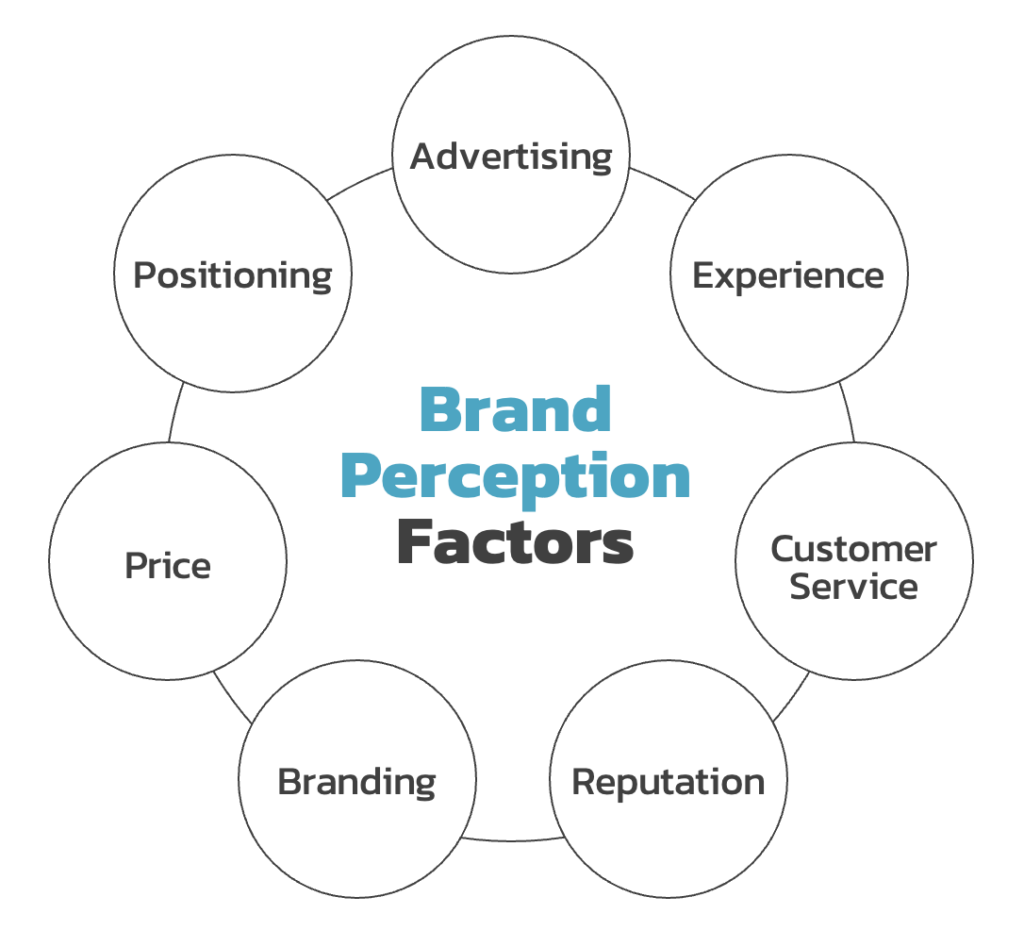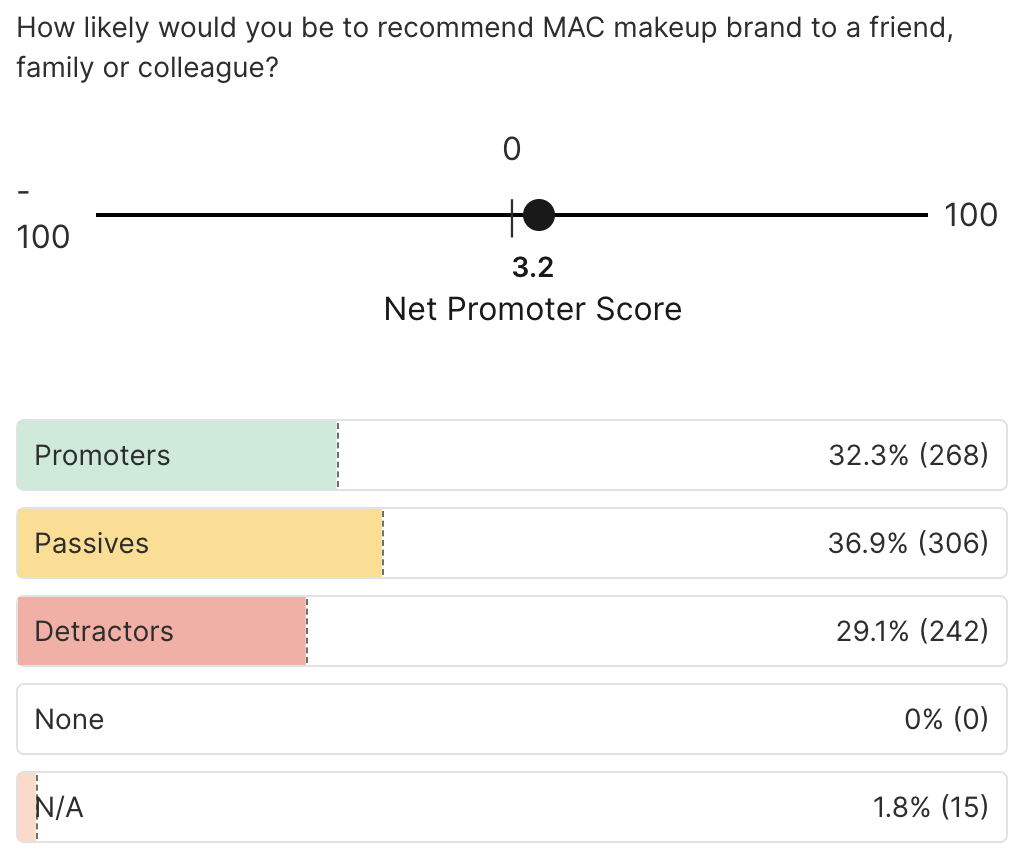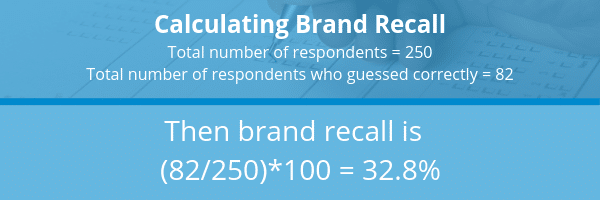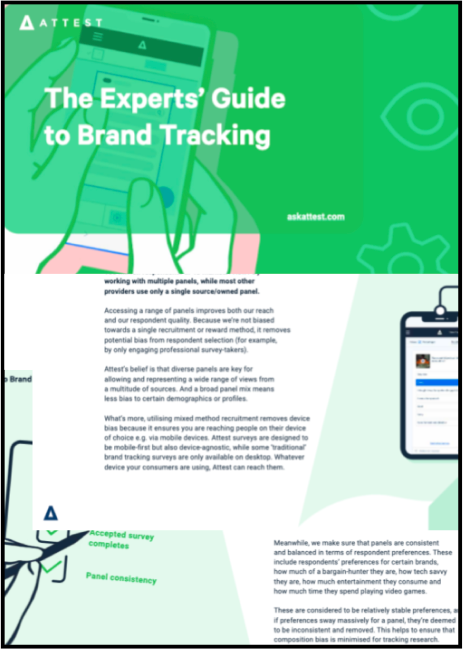20 Brand tracking questions every brand manager should ask

24 successful entrepreneurs and brand managers share the 20 most important questions that businesses should be asking their customers.
Successful entrepreneurs and brand managers share the 20 most important questions that businesses should be asking their customers.
Are you launching a brand perception survey soon to find out what your target group really thinks about you, but you’re not sure how or what to ask? Don’t worry, we’ve got your back.
Based on the advice of 24 successful entrepreneurs, brand managers and our own team of research experts, we’ve made a list of the exact questions every brand manager should ask their customers to measure brand perception.
Looking for intel into how your target customers act and buy? Check out our top consumer behavior survey questions.

Why is brand tracking so important?
If you had a direct line to your customers, what would you ask them? Market research offers the opportunity to uncover a wealth of insights — information you can use to enhance your product or service, improve your marketing or gain a competitive advantage. Here’s how some top brands found success from their brand tracking projects.
When it comes to evaluating company performance, brand tracking is worth its weight in gold, so let’s make sure you get it right. As well as being a way to measure the success of some marketing activities that are otherwise pretty difficult to identify, brand tracking can help you gain a full understanding of your market and how your brand stands against its competitors.
Before we dive into the main list, here’s a taster of the questions Brand Managers should ask their customers:
And there’s more! Here’s how brand tracking can help your business and what you need to know before you create your brand tracker.
How to use brand survey questions
Simply launching a survey with all these questions could lead to some pretty chaotic results that really don’t tell you anything. Pick good survey questions based on the goal of your survey.
For example, you may be interested in brand perception and how customers view your brand qualities against your competitors. Or, perhaps you’re more interested in brand awareness or brand recognition and want to see that grow over time; this can have huge impacts on growth of market share. Perhaps your survey needs to serve a rebranding process, where your brand’s image or company name is under evaluation.
The goal of your brand survey dictates the questions you want to include. Many use a brand management tool or customer insights software to help set up their surveys.
When creating your brand survey, remember to ask the right demographic questions to better understand how your target audience reacts to your brand differently from other customer cohorts.
You should also uncover how far along people are in their buying journey with you, as this may impact results.
All of this provides more valuable insights and additional context for your answers so you can craft stronger and more targeted campaigns based on the results, and be more confident in the outcome. Let’s dive into these questions!
Get a head start with our brand tracker template!
Make data-driven brand decisions based on what consumers think about and want to see from your brand
Get started!Brand tracking survey questions
Which questions fall into this category? Essentially, those that directly relate to the usage of a product and showcase brand built efforts. Brand trackers determine how customers buy and use your products, and will help your customer insights team better understand your target audience.
1. Which of the following, if any, have you purchased in the past 12 months?
It’s important that you qualify all prospects before considering their results for your study. You want to make sure you’re talking to the right audience, so obtaining demographic information is important too.
These questions tend to significantly reduce your audience size, but if you’re performing market research for, let’s say estate planning, do you really want to include a 16-year-old student in your test group? Probably not.
Bret Bonnet, Quality Logo Products
2. On a scale of 1-10 (with 10 being high), how would you rate [Brand] on the following attributes?
The most important thing for businesses to know about their brands is how well aligned their desired brand attributes are with audience (prospect, customer, employee) perspectives. The way we’ve done this is by asking this question. We provide a list of desired brand attributes — generally between 5-10, which would include things like “high quality,” “innovation,” “customer service,” etc.
This type of feedback is very important because, as we all know, companies don’t define their brands — consumers do. Knowing how consumers are currently defining your brand, and comparing those perceptions to your desired brand identity, can help you spot opportunities for improvement as well as areas of strength that you can capitalize on through your communications.
Linda Pophal, Strategic Communications
3. How would you feel if you could no longer use [Brand’s] product/service?
Let’s get into some qualitative data on how people feel about what you do — specifically, how they’d feel if they couldn’t use it anymore. The answer to this question will give you valuable insight into how important your product or service is to your customers, how much they value it, and how easy it would be for them to replace.
4. Why do you buy from [Brand]?
I survey all our customers twice a year, and this is the most important question I ask. Whatever reasons they give, you no longer need to guess what your customer wants. You can then make these important points and USPs more obvious in your marketing and communications. This should result in increased sales and customer loyalty.
Adam Watson, Hollywood Mirrors
When we asked this question in 2016, we expected price to be the number one reason people bought from us. It turns out 74.3% of the responses were related to service and communication.
This prompted us to invest more in technology that helps our team communicate with customers in a timely manner. We believe it is why we have expanded into new markets in 2017 and experienced excellent year-over-year growth.
Mike Wolfe, Delgado Stone Distributors
Answers to this question give us data about how our marketing is performing. We can separate which messages reach consumers and which ones do not. The data also tells us which features of our product or service appeal most to consumers. When we launched a new integrated accounting solution, we used the data to further improve the features that have the most impact on consumers. We made our software completely seamless and automatic and marketed it as such and it was a huge hit.
James Nowlin, Excel Global Partners
When we did our first market research, this question allowed us to understand how a potential customer would search for our service on the internet and this is the way we have generated millions of dollars in revenue positioning us in search engines with the same exact keywords that the users really use for search.
Cristian Rennella, oMelhorTrato.com
5. Where do you buy [Brand’s] products/services from?
Do you know which customers are most likely to buy from which distribution channels? Are you matching the needs of your target customer? This question helps you figure out if your brand marketing activities and sales channels are aligning with where your customers are actually spending their money. Streamline your work and concentrate your efforts on the areas that matter.
Brand perception survey questions

Brand perception is all about feeling, specifically what the customers feel your brand represents. These can be particularly helpful answers in determining how aligned you and your customers are in terms of company values–and how strong their brand loyalty is. An individual customer’s perception of a brand will come from multiple sources: so it’s a holistic way of looking at your company’s overall image.
6. Is it obvious what [Brand’s] purpose is?
New companies pop up in the market, or the existing ones innovate until their products are basically alike. If you’re not looking to start a fight for your customers’ attention using product pricing, it’s good to know that brand purpose is increasingly important to consumers when making a purchasing decision.
Building a strong brand purpose that aligns with the views of your target customer can strongly increase the likelihood that they’ll buy from you — it’s important that if your brand has a purpose, it’s immediately obvious.
Don’t forget to give these insights more context. Combine this question with another one in your brand awareness survey that asks people to describe what your purpose is, to see if it matches what you were aiming for. If people think you have a very clear brand purpose, but it doesn’t align with what your product marketing team had in mind, it’s time to change your messaging.
7. What was your first reaction to [Brand]?
First impressions are incredibly important, no matter how many retargeted ads you throw at people who left your website.
In a world where we are constantly scrolling, swiping, and shopping, our attention span has become incredibly short. In 2000, we were at about 12 seconds. That’s right, even back then, you didn’t even have time for a quick elevator pitch. It’s gotten worse: only twenty years later, we struggle with holding our attention for only 8 seconds.
Meanwhile, more marketing messages than ever are being fired at us. So, how do we decide which brands we like, what ads we click on, and why we bounce off a webpage in a matter of seconds?
Knowing you literally have no time to lose when trying to reach your customers might show you that a touch of mystery in your marketing efforts should be used with care. Asking what first caught someone’s eye, especially someone who, in the end, chose to buy from you, will help you create stronger brand messages and engaging content that will lure potential customers into that buying journey.
8. How would you describe [Brand] to a friend?
You can define your brand on paper, but to know if it translates correctly to the real world, you’ll have to ask your customers. You might be surprised to hear what words they use to describe you. This type of question is critical for brand perception surveys.

This can serve as a great follow-up question after the NPS. Finding out how someone would describe your brand in their own words lets you see what stands out most for them, and whether that’s aligned with your own image of your brand.
Asking for a description can help you determine how your brand’s personality is perceived. Moreover, it will show if customers are more focused on things like product features, price and availability, or if they can’t help but mention what you stand for and what your mission is.
9. How likely would you be to recommend [Brand] to a friend, family or colleague?
Here’s an example of an NPS question asked in a brand tracker focusing on makeup brands.

This Ultimate Question, as founded and described by Fred Reichheld, is designed to measure customer loyalty and is the question behind your Net Promoter Score.
If a customer makes a personal referral to someone they care about, it is very likely they are a loyal customer and promoter of your business. It encompasses not only what a customer thinks, but what they feel too. NPS is a customer experience metric that holds value to any company.
Lisa Kenny, SynGro
The reason this question is so important is it lets you know where you stand with the customer and where to begin the conversation.
If someone’s a “detractor,” you need to fix their concern or be prepared to lose their business and have them vent about you on social media.
If someone’s a “passive,” you need to determine what you can do to move them to “promoter” versus letting them slide back to a “detractor.”
Finally, if someone is a “promoter,” you want to get a testimonial, referral, or them talking about you on social media.
Tom Smith, Insights from Analytics
10. What are your biggest pain points with the current market offerings?
Asking this question highlighted the functionalities that were lacking in my competitor’s products and allowed me to conduct further tightly-focused market research targeting these gaps. By doing so, I eventually succeeded in building a platform with functional features that were otherwise missing in the market, thus solving a problem for users and differentiating my product from a sea of competitors.
Sophie Knowles, PDF Pro
The answer to this question can be game-changing. For instance, my client who is a life coach, originally thought that her clients were craving someone to talk to, someone that would listen.
But after asking this crucial question, she found her clients were frustrated with previous coaches and therapists that only allowed them to talk and air out their feelings. In fact, her clients wanted her to not only listen but also provide a structured game plan of what they should do at each turn.
Britney Kolodziej, JAM Marketing Group
The reason this question is important is that unless your product is truly 100% unique, your product will be compared to how the need you are fulfilling is met by other businesses.
When we started our business to provide Shopify store design and marketing, we asked this question. By far, the biggest finding was that customers hated the poor communication and lack of ability to discuss a project over the phone before committing. Based on this, we made this one of our key USPs, and use this in all of our branding and marketing.
Adam Pearce, Blend Commerce
We run a dental clinic, and we’ve had huge success by asking this question. We tend to bring the change they want to see, whether it’s lowering our rates or changing the environment. Not only does this give our firm a huge boost in clientele, but this enables us to evolve for the better.
Dr. Ameerzeb Pirzada, Z Dental Studio
Build your brand based on fast, reliable consumer insights
Try Attest’s brand tracker to get accurate insights in hours, not days
Track your brandBrand functionality questions
You’ve guessed it. These questions are designed to find out how your product or service actually works, and whether the user genuinely benefits from it. Use these answers to determine your brand’s ability to satisfy consumer needs- and build your brand from there..
11. What problem/s are you trying to solve?
When you know the problem, you can address it. And, as you figure out more of your customers’ problems, you can build a more robust (and valuable) product or service that solves everything.
Kenneth Burke, Text Request
I work in inbound marketing, so creating accurate buyer personas is crucial to creating targeted content. When asking this question, often people are willing to talk about what obstacles are in their way to reach a certain goal. With that information, I am able to create content that helps these people or businesses get to the core of their problems and eventually solve them.
Kay Nordenbrock, KN – Consulting & Copywriting
If you can help customers fix their biggest problems then you will always be a partner, not just a vendor. I have customers who have come back many times looking for help over the 16 years since I started a global branding firm. It’s because they know we care and that we love solving their problems so they can sleep well at night.
Paige Arnof-Fenn, Mavens & Moguls
Regardless of how good you think your idea is, if your customers or a potential market are not interested, it simply won’t work. Organized Health asked this very question and, based on the results, we slightly pivoted our target audience.
You have to listen to what people are saying. If that means changing your idea or perhaps completely discarding it, it has to be done. Give your customer base what they want, and rewards will come your way.
Dylan Macdonald, Organised Health Technologies
At the end of the day, unless you are able to make your customer’s life a little easier/better/more efficient, you are probably not providing them with something they should spend their money on.
Dan Salganik, Visual Fizz
Based on Maslow’s Hierarchy of Needs, or even our own individual experience as consumers, we know products are purchased based on a level of safety and comfort the consumer is feeling. If a consumer doesn’t feel the product solves a need, they won’t feel pushed to make a purchase.
Kelley Lauginiger, American Freight
12. How would you rate your last experience with [Brand]?
Last impressions are just as important as first ones — if not more. For most companies it’s easier and cheaper to get clients to come back, rather than to start a new sales cycle with a new customer. To achieve this, it’s important to focus on thank-you pages, shipping updates and next-purchase deal offers as in your initial content marketing.
Don’t lose focus once the deal is closed. This question will help you determine whether your sales process is contributing to or detracting from your brand image.
The image your customers form of you as a company, one they’d possibly return to for their next purchase, is still being formed after they buy your product, or even after they receive it. Those are extra moments in which you can reinforce your mission, vision and values, making sure you’re the first one they think of again for a second purchase.
13. How much would you expect to pay for [XYZ]?
Price testing is an important part of launching a new product, but it’s never too late to consider whether your product or service meets price expectations in the current market. You could be losing potential customers by making your product too expensive, or missing out on profit margin if you’ve massively undervalued your service.
14. How can [Brand] do better?
Every brand should ask their customers how they can further meet their needs. This can be tricky in a non-service-based industry. For our ecommerce jewelry business, we segmented our email list to our VIP customers (as defined by frequency of purchases) and sent an open-ended survey.
We came back with some great suggestions, including a more robust rewards program, early access to sales and promotions, and suggestions for content they would like to see more of.
This not only gave us valuable insight to better serve our loyal customers, but it also increased engagement with our VIP customers as they felt a part of the process to better their experience.
Kimmie Marek, 7 Charming Sisters
This is a great open-ended question. Consumers, especially those that purchase your products, are each connected to your brand in different ways. By asking what they want to see, you are able to get a sense of the way your consumers connect with your brand.
Do they want to see more communication? Products? Support? Without asking this question, it is difficult to get a feel for this type of thing. A company doesn’t always need to churn out new products to grow their brand. If your consumers want to see something other than products, make it happen.
Jameson Slattery, Colorescience
This question lets us improve customer retention by making the process of buying and using the product continuously smoother. It is also beneficial for content, social media, and promotional efforts: we know (after developing the features and services requested by the customers) what benefits to communicate to the audience, and in what words.
Using this approach, we learned that in some locations users were primarily looking for free shipping for their international gifts and were willing to compromise on other aspects of the delivery service. So we knew how to develop the service in these locations and what to advertise to the customers.
Natasha Kvitka, Gift Baskets Overseas
15. If you were in charge of this brand/product/service, what’s the first thing you’d change?
Want to know what would make customers come back, stay or buy in the first place? Make them the CEO of your company, or at least for a few minutes. Your customers will very likely have things they’d change about your brand if they were in charge, whether it’s a small tweak to a product description through to a complete brand refresh.
Nobody knows better what your customers want than your customers. By asking them to tell you the first thing they’d change, they’ll prioritize.
Find out what people think about your brand
Get real insights from your target audiences fast with Attest’s brand tracker, and make smarter decisions about your brand
Get your brand insightsBrand recall questions
Measuring brand recall is about finding out how memorable your brand is, usually with little prompting. With time, you want your brand to be at the forefront of customers’ minds for your specific industry/product/service.
16. What do you think is [Brand’s] best quality?
No, you’re not fishing for compliments or wanting to show off: this question can actually help you identify why people consider you or buy from you. The next step? Double-down on that — or step it up in other areas, depending on the outcome of the rest of your survey.
What people like about you most isn’t necessarily the reason why they purchase your products, but it certainly does help: consumers are buying more and more from the heart, not from the head. In fact, Harvard professor Gerald Zaltman recently concluded that 95% of our purchase decision-making takes place in the subconscious mind.
17. How would you describe [Brand’s] product?
That’s right, don’t just ask how they would describe your business, ask about your products and services too. This gives you even more insights into the buying reasons your customers have. You could identify gaps here, or undiscovered markets full of people who would love to use your product, but don’t feel addressed with the way you market it right now.
18. Thinking about companies that provide [X], what companies come to mind?
This question is for unaided recall and can be followed by a second question for aided recall, “Are you aware if any of the following companies provide X?”The combination of these two questions explains how well you are known by your target market. It should be analyzed by looking at current customers and potential customers, separately. The responses to these questions tell us how much marketing we need to do and whether it should be mass marketing or specifically targeted.
It is also often used to determine the effect of advertising. For one client, I administered a survey prior to, and after running television advertising, we saw a significant increase in awareness after the TV advertising campaign.
As time went on, the advertising was stopped. As we continued to administer the survey, we watched brand awareness significantly decline. Senior management began discussing the need for TV advertising.
Neal Kreitman, ABN Partners

19. Which competitors, if any, did you consider when shopping for [XYZ]?
This question yields so much data. Sometimes you think you know who your competitors are, but answers to this question will often surprise you. We’ve uncovered competitors we didn’t know we had.
We then use the answers to investigate those competitors online and see how their brand and their website compare to ours i.e., what are their search engine rankings, how successful are they on social media, where else do they appear online and ultimately, the big question, what can we learn from this competitor?
Danielle Kunkle, Boomer Benefits
The benefits of tracking brand perception
Understanding brand perception is a crucial part of developing a successful business. A strong knowledge of how customers perceive your business is the most effective way to boost company growth while saving time and money in the process.
Implementing a brand perception survey helps you get all the information you need to develop your brand identity and adjust your products and marketing strategy to shifts in customer demands and expectations.
Successfully measuring brand perception is a task in itself; it comes from product use, experience, functionality and reputation, taking a number of factors into account. It’s a notoriously difficult, ‘multidimensional’ metric, but it’s not impossible. The main difficulty is that it’s determined exclusively by customers, so once you’ve nailed your brand perception surveys and comms, you’ve won half the battle.
Tracking brand perception helps maintain a concrete, positive connection with your customers. By listening to, and acting on feedback from your customers, they will feel valued and more likely to engage with your brand in the future.
The image a brand manager has of their brand may differ hugely from how customers actually perceive it: evaluating brand perception can help you close this gap and improve alignment.
Track your brand (with expert help!)
With Attest you get designated support from our experts in the Customer Research Team, to help you gather truly useful brand insights
Speak to our experts today!Track your brand awareness in-house
So, there you have it — the 20 burning questions brand managers and business owners want and need answers to!
It just goes to show that you don’t have to ask hundreds of questions in your brand awareness surveys to get key data for your business, and that you can monitor your brand health in-house. If you think this would suit you best, make sure check out our guide on how to do it yourself, full of valuable tips to get professional-level results.
Back to brand tracking know-how. Now you have your questions, you need to create your survey; if you’re not sure where to start, check out our brand perception survey template.
The responses to these 20 questions can give you reliable insight into everything from how you’re currently performing and what you could be doing better to who your competitors are and how you compare.
The key is to make sure you’re asking these questions at regular intervals. Successful brand tracking is not a one-off survey, but rather a continuous effort for businesses. Market research follows the same principles: work out what you’re doing right/wrong, make adjustments, measure the results, rinse and repeat.
Monthly or quarterly tracking might be best suited to measuring the success of a timed event, like an advertising campaign. It’s a good idea to ask questions before, during and after the event.
Annual or bi-annual tracking is also super useful for evaluating changes in customer usage or sentiment. This kind of tracking helps you spot any changes in your brand’s awareness and perception before they become an issue.
This is invaluable information for developing your business strategy, and with an online customer survey, it can be at your fingers and on your screens in next to no time.
If you need support with your brand tracking strategy, check out our list of 11 brand tracking tools for marketers.
If you’ve got a lot on your plate at the moment and want to outsource your brand tracking work. Have a look at our comprehensive list of 15 brand tracking companies that’ll help you enhance your market research.
A brand tracking survey is a tool which helps businesses to monitor their brand’s performance, usually over a period of time. The survey provides consumer feedback which determines your company’s brand health, helping you to make informed decisions to increase sales and deliver more effective campaigns.
A brand survey’s goal is to understand your brand identity, according to your existing customers. For determining brand perception, a great question is “How would you describe our brand to a friend?”. For brand functionality, “How would you rate your last experience with [Brand]?” and for brand awareness, we’d recommend “What was your first reaction to [Brand]?”. In terms of brand tracking, start simple with “Why do you buy from us?”. Read on to discover a further 16 recommended brand tracking questions.
Brand tracking determines the health of your brand by providing valuable insights into your company’s performance. It helps you stay ahead of the competition by catering more directly to your customers’ needs, working out what you do well, and finding out which areas need attention. It’s essential to improving your brand’s image and supporting marketing efforts by gaining a different perspective. To reap the full benefits, read our brand tracking guide.
Tell us what you think of this article by leaving a comment on LinkedIn.
Or share it on:

